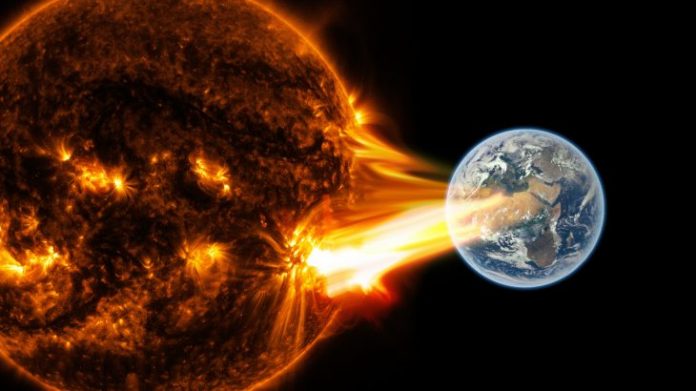Earth is under attack. Constantly. A stream of high-energy particles comes our way every day and night from the Sun, whose solar flares and coronal mass ejections are unpredictable but common. Mostly, Earth’s magnetic field protects us and displays beautiful aurora around the Arctic and Antarctic circles, but just occasionally, it’s just too much.
It the past, a massive once-a-century solar storm could pass without incident, but now it could knock out the electrical grid, communication systems and satellites. A 2013 study by Lloyd’s of London and Atmospheric and Environmental Research concluded that a massive solar storm could cost US$2.5 trillion dollars, and its effects could last for over a year.
How common are severe solar storms? We know about a few; the most famous is the ‘Carrington Event’ of late August and early September 1859, when astronomer Richard C. Carrington observed the most powerful geomagnetic storm known up to date. Back then, the only infrastructure affected was the global telephone network. Nowadays, a storm of similar intensity could have catastrophic effects. Solar storms in Quebec, Canada in 1989 and in and Malmö, Sweden in 2003 knocked-out electricity grids.
Trouble is, we’ve not been monitoring this stuff for long, so long-term trends are a mystery. Exactly what’s happening on the sun’s solar surface, and therefore what might be headed our way, has been measured since 1957 using the ‘Dst’ index, which is fed data every hour from stations across the globe. The value of this parameter ranges from -20 to +20 nanoteslas; it’s estimated that the Carrington Event was around -850 nT.
However, geologists at Lund University in Sweden have uncovered more evidence for a massive solar storm in the distant past. Using drilled samples of ice cores from Greenland formed over 100,000 years they have detected evidence of a very powerful solar storm that occurred in 660 BCE. “If that solar storm had occurred today, it could have had severe effects on our high-tech society”, says Raimund Muscheler, professor of geology at Lund University, who previously detected evidence of massive solar storms in 775 and 994 CE.
Muscheler says that the research proves that massive solar storms are rare, but a naturally recurring effect of solar activity, and that the direct observations made over the past 70 years are insufficient.
Muscheler insists we’re more vulnerable than we think. “That’s why we must increase society’s protection again solar storms”, he says. “Our research suggests that the risks are currently underestimated. We need to be better prepared”.
In separate research, mathematicians think they’ve proved that massive solar storms are more unlikely than previously thought. Three mathematicians and a physicist from the Universitat Autònoma de Barcelona (UAB), the Mathematics Research Centre (CRM) and the Barcelona Graduate School of Mathematics (BGSMath) calculated that the probability in the next decade of a potentially catastrophic event for the Earth’s telecommunications, of ‘Carrington Event’ proportions, is between 0.46% and 1.88%.
That’s far less than estimated before. “In 2012, the results reported in scientific literature estimated the probability to be around 12%, ten times more than our more pessimistic estimation,” says David Moriña, first author of the study and postdoctoral researcher explains.
However, they still warn about its potentially devastating consequences. “A probability close to 2%, which is what we have calculated for a highly intense storm, should not be looked over if we take into account the consequences of such an event,” says Professor Pere Puig, one of the authors of the paper.
“Governments should have action protocols to react to such disasters, in order to inform and calm the population left without electrical energy and no way to communicate … there will be very little time of reaction before the unforeseen arrival of this type of storm”.













